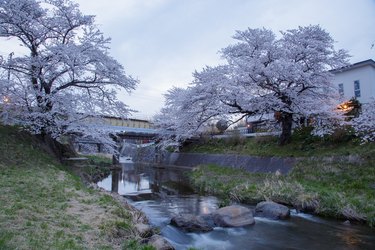
Many gardeners are aware that tree roots can damage water pipes, but the roots are a threat to gas lines, as well. When planting trees near gas lines, consider the mature size of the tree as well as the proximity to any underground pipes, lines or cables. When planted too close to a gas line, vigorous tree roots are capable of moving the lines and destroying the protective coating on the pipes. Tree maintenance and accidents can also damage gas lines.
Tip
Tree roots can damage any kind of underground pipes, gas lines or fiber-optic cables.
Video of the Day
Tree Root Expansion
Expanding tree roots can move gas lines, especially small-diameter lines in home landscapes. In addition, roots growing around gas lines exert a tremendous amount of pressure on the line and are capable of squeezing it enough to cause weak points and cracks in the pipeline's structure, allowing the escape of gas. Roots girdling pipelines also interfere with the pipeline workers' ability to inspect and maintain the lines.
Video of the Day
Deep-Root Fertilizer Holes
Deep-root tree feeding involves drilling a series of 6- to 12-inch deep holes over the tree's root zone. That's deep enough to pierce shallowly buried gas lines in home landscapes. If the pipes are pierced, the escaping gas is a health and fire hazard and also adversely affects the health of nearby trees and shrubs.
Lightning Strike Damage
Even trees not planted directly over gas pipe lines can cause damage if struck by lightning. The lightning's energy passes down the tree into the soil, following the roots and vaporizing any moisture present in the soil. If tree roots extend near a gas line, the violent moisture evaporation causes shifts in the soil structure that can crack the gas line.
Roots of Falling Trees
The roots of trees planted directly over gas lines grow around the lines, which not only moves the gas lines but breaks the line if the tree is removed or falls over. For example, during Hurricane Katrina, a gas line was pulled out of the ground when a tree fell over. Should you ever need to remove or transplant your tree, it will be almost impossible to do so without serious damage to both the gas line and the tree's roots. For this reason, many municipalities require trees to be planted a specified distance from underground utilities.
Gas Pipe Damage
Gas pipelines have a plastic coating on the outside designed to prevent corrosion. Tree roots may pierce and damage the exterior coating and make the pipelines susceptible to breakage. In addition, if the pipeline is within a utility company's right-of-way or easement, the utility can send out workers or contractors to severely prune or cut down any shrubs or trees that they determine may cause damage to lines both above and below ground. Make sure you know where the right-of-way and lines are located before planting anything more than grass and shallow-rooted wildflowers in that area.
Pipe Damage Prevention
Many municipalities require you to contact your local utility providers to mark the locations of all utilities, including gas lines, before digging; even if not required, it's a sensible precaution that can save you time and money. Plant small trees and large shrubs at least 5 to 10 feet away from gas lines, and large trees much farther, since as a general rule tree roots extend out at least as far as the tree's canopy, and depending on the tree species, three to four times the height of the mature tree. Your local government may specify exactly how far away from utility lines you can plant.